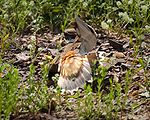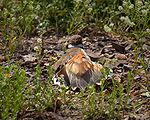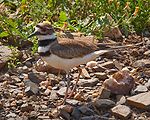- Distraction display
-
Distraction displays, also known as deflection display, diversionary display or paratrepsis,[1] are anti-predator behaviours used to attract the attention of an enemy away from an object, typically the nest or young, that is being protected.[2] They are particularly well known in birds but noted also in fish.[3] Distraction displays are however not very well defined and the definition has been the subject of much debate. They are sometimes classed more generically under "nest protection behaviours" along with aggressive displays such as mobbing.[4]
It has been suggested that distraction displays exist mainly in birds since they have the ability to escape at the last moment out of reach of ground predators. Displays are used mainly for ground predators and rarely used against avian predators.[5]
Several variations are known in these distraction displays. Nesting male three-spined sticklebacks when approached by groups of conspecifics will move away from the nest and simulate feeding on the substrate. Adults will feed on the eggs of nesting conspecifics.[6]
False brooding is an approach used by plovers. The bird moves away from the nest site and crouches on the ground so as to appear to be sitting at a nest and allows the predator to approach close before escaping.[7]
Injury feigning is one of the more common forms of distraction. The broken-wing display is particularly well known in nesting waders and plovers and doves such as the Mourning Dove.[8] Birds that are at the nest walk away from the nest with one wing hung low and dragging on the ground so as to appear as an easy target for a predator. Several interpretations have been made for the evolution of the behaviour and the cognitive abilities involved.[9]
Another display is the rodent run which is seen in plovers[10] as well as some passerine birds.[11][12] Here the nesting bird drops to the ground or moves away creeping along with the head held low and making turns as if dodging imaginary obstacles.[13]
- Killdeer (''Charadrius vociferus'') broken wing act
Costs
If a signal is not honest, predators can quickly learn to ignore distraction displays.[14] Distraction displays have their cost and displaying adult birds are sometimes captured by the predator being distracted or by other opportunist predators.[5][15]
References
- ^ Armstrong, Edward A. (1949) Diversionary display. Ibis 91(2):179-188 doi:10.1111/j.1474-919X.1949.tb02261.x
- ^ Barrows, Edward M. (2001) Animal behavior desk reference. CRC Press. 2nd ed. p. 177 ISBN 0849320054
- ^ Ruxton, Graeme D; Thomas N. Sherratt; Michael Patrick Speed. (2004) Avoiding attack: the evolutionary ecology of crypsis, warning signals and mimicry. Oxford University Press. ISBN 0198528590. p. 198
- ^ Timothy M. Caro, Sheila Girling (2005) Antipredator Defenses in Birds and Mammals. University of Chicago Press. ISBN 0226094367 pp. 343-347
- ^ a b Sordahl, Tex A. (1990) The risks of avian mobbing and distraction behavior: an anecdotal review. Wilson Bull. 102(2):349-352 PDF
- ^ Whoriskey, F. G. 1991. Stickleback distraction displays: sexual or foraging deception against egg cannibalism. Animal Behaviour, 41:989–995.
- ^ Walters, Jeffrey R. (1990) Anti-predatory behavior of lapwings: field evidence of discriminative abilities. Wilson Bull. 102(1):49-70 PDF
- ^ Thomas S. Baskett, Mark W. Sayre, Wildlife Management Institute, Roy E. Tomlinson (1993) Ecology and Management of the Mourning Dove. Stackpole Books. ISBN 0811719405 p. 167
- ^ Ristau, Carolyn A. (1991) Aspects of the cognitive ethology of an injury-feigning bird, the piping plover. In Cognitive Ethology: The Minds of Other Animals : Essays in Honor of Donald R. Griffin By Carolyn A. Ristau, Donald Redfield Griffin. Lawrence Erlbaum Associates. ISBN 0805802525 p. 91-126
- ^ Byrkjedal, Ingvar (1989) Nest defense behavior of lesser golden-plovers. Wilson Bull. 101(4):579-590 PDF
- ^ Rowley, Ian (1962) "Rodent-Run" Distraction Display By a Passerine, the Superb Blue Wren Malurus cyaneus (L.) Behaviour 19(1-2):170-176
- ^ Eric Duffey, N. Creasey (1950) The "rodent-run" distraction-behaviour of certain waders. Ibis 92(1):27-33 doi:10.1111/j.1474-919X.1950.tb01730.x
- ^ Marie Read (2005) Secret Lives of Common Birds: Enjoying Bird Behavior Through the Seasons. Houghton Mifflin Harcourt, ISBN 0618558721. p. 29
- ^ Stuart-Fox, Devi (2005) Deception and the origin of honest signals. Trends in Ecology and Evolution 20(10):521-523 PDF
- ^ Gochfeld, M. (1984) Antipredator behaviour: aggressive and distraction displays of shorebirds. In: Shorebirds: breeding behaviour and populations. Behaviour of marine mammals (Ed. by Burger, J. and Olla, B.), pp. 289–377. New York: Plenum Press.
External links
Categories:- Animal communication
- Antipredator adaptations
- Bird terminology
Wikimedia Foundation. 2010.



